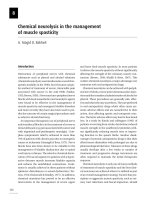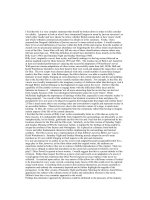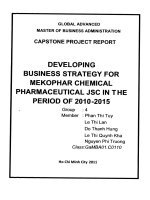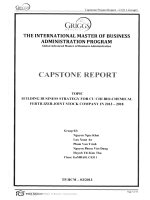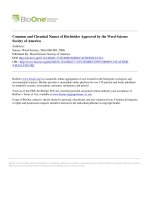Chemical Procedures
Bạn đang xem bản rút gọn của tài liệu. Xem và tải ngay bản đầy đủ của tài liệu tại đây (38.06 KB, 8 trang )
PROCEDURES FOR WATER ANALYSIS
USING LAMOTTE WATER TEST KITS
ALKALINITY
Normal conditions of alkalinity for natural waters are associated with the carbon dioxide,
bicarbonate, carbonate and hydroxide components. These factors are characteristic of the source
of water and the natural processes taking place at any given time. The measurement of alkalinity
indicates the amount and type of alkaline materials present.
TEST PROCEDURE FOR ALKALINITY
l. Fill the sample chamber to the 5 ml line with water to be tested.
2. Add one Phenolphthalein Tablet to the test sample. Cap and shake to dissolve the tablet. If
the sample remains colorless, record the Phenolphthalein alkalinity as zero and skip to step 4.
If a pink color appears continue with step 3 to determine the P-alkalinity.
3. Fill the titrator (syringe) with Alkalinity Titration Reagent B and titrate until the pink color
disappears. The color may be very faint so hold the sample chamber over a white piece of
paper. Record the phenolphthalein alkalinity reading as ppm CaCO3. Each small division =
4 ppm. (Do not empty burette yet). Go to step 4.
4. Add one BCG-MR Tablet and swirl to dissolve the tablet. A blue-green color will appear.
5. Without refilling, continue titrating with the syringe containing the Alkalinity Titration
Reagent until a pink color forms. Record the result as the total alkalinity (T-alkalinity). The
results obtained from these two tests offer a means of classifying the alkalinity present as
carbonate, hydroxide or bicarbonate alkalinity. P- and T-alkalinity are expressed as ppm
calcium carbonate (CaCO3).
Readings are made directly from the titrator. For example, if the tip of the plunger is 3
divisions below line 80, the test result is 80 + (3 divisions x 4) = 92 ppm. (Each minor
division = 4 ppm)
ALKALINITY RELATIONSHIP TABLE
CARBONATE
BICARBONATE
ALKALINITY
HYDROXIDE
ALKALINITY
ALKALINITY
P=0
O
O
T
P < 1/2 T
O
2P
T-2P
RESULTS OF TITRATION
P = 1/2 T
P > 1/2 T
O
2P
2T-P (AMMONIA
2(T-P)
AMMONIA
NITROGEN)
O
O
=T
T
O
Ammonia Poccurs
in low quantities (less
than 1 ppm) in unpolluted
fresh water andOmay be
detected by means of Nessler's Reagent which reacts with ammonia to form a yellow color, the
amount of color developed being directly proportional to the amount of ammonia present
l. Fill test tube (0124) to the 5 ml line with water to be tested.
2. Add one Ammonia #1 Tablet (3968) and one Ammonia #2 Tablet (3969). Cap and mix until
tablet disintegrates.
3. Wait 5 minutes.
4. Facing a source of natural light, hold test tube flat against the white section of the ColoRuler
(6665-01). Match the sample color to a color standard. Record as mg/l Ammonia-Nitrogen.
NOTE: Sample may be turbid. This will not affect the test results.
Express results as Ammonia-N. To convert results to Ammonia, multiply reading by 1.3 and
record as mg/l Ammonia (no need to convert).
CARBON DIOXIDE
l. For reliable results the test should be made on a freshly obtained sample, preferably a sample
obtained with a minimum of contact with the air (avoid splashing, etc.). The sample chamber
(Code 0299) is filled to the 20-ml mark with the water to be tested.
2. Add 2 drops of Phenolphthalein Reagent (Code 2246). If the sample turns pink, no free
carbon dioxide is present. If the solution is colorless titrate with Carbon Dioxide Reagent B
(Code 4253) until a faint pink color is produced and persists for at least 30 seconds. The
sample is gently agitated during the titration. Read test result in ppm Carbon Dioxide where
the plunger tip meets the titrator scale.
CHLORIDE
l. Fill the sample titration chamber (0771) to the 15 ml line with the water sample to be tested.
2. Add one drop of Phenolphthalein Indicator (2246) to the sample. If the solution remains
colorless, proceed to step 3. If the sample turns pink, add Sulfuric Acid 0.5N (6090), one
drop at a time, mixing after each drop, until the pink color disappears.
3. Add 3 drops of Chloride Reagent #l (4504) to the sample in the titration chamber. Place the
cap on the chamber and swirl to mix. A yellow color will develop.
4. Fill the titrator with Chloride Reagent #2 (4505) in the manner described in the instruction
manual. Insert the titrator in the center hole of the cap.
5. Titrate with Chloride Reagent #2 until the yellow color is permanently changed to a salmon
color. Be careful not to overshoot the endpoint.
6. Read the test results in ppm Chloride where the plunger tip meets the titrator scale. Each
minor division = 4 ppm.
High Chloride Readings
For high chloride readings, the sample being tested must be diluted carefully with deionized
water to bring it within the range of the test procedure. The results are multiplied by the
dilution factor.
DETECTION OF SYNTHETIC DETERGENT IN WATER
Part 1
l. Using the calibrated plastic tube, measure 5cc of water to be tested and add this to the screw
cap bottle marked "TEST SAMPLE ". Using the small plastic spoon, add a level spoonful
of the pH Adjustment Reagent to the sample of water and shake the bottle until the powder
has dissolved.
2. Fill the dropper with test reagent by squeezing the rubber bulb. Add this amount of test
reagent to the bottle marked "TEST SAMPLE".
3. Apply the cap to the "TEST SAMPLE" bottle and shake the mixture for one minute.
4. Allow the "TEST SAMPLE" bottle to stand until the two layers of the mixture separate. The
water layer will settle to the bottom and the test reagent layer will rise to the top. If a
detergent product is present in the test sample, it will displace some of the color from the test
reagent layer and the water layer will become colored. Very high concentration of a
detergent product can cause all of the color to leave the test reagent layer and move into the
water layer.
Bottom (water layer) colorless .......... No detergent in sample
Both layers have color .................…...Detergent present
Top (test reagent) layer colorless …...Very high detergent content
Part 2
The test (Part I) determines if a detergent product is present in water tested. The bottle
marked "REFERENCE SAMPLE " is used to determine the amount of detergent present.
1. Using the calibrated plastic tube, measure 5 cc of water that is free of detergent products
(deionized water) and add this to the bottle marked "REFERENCE SAMPLE". (On field
trips it may be necessary to carry a supply of deionized water.) Using the small plastic
spoon, add a level spoonful of the pH Adjustment Reagent to the sample of water and shake
the bottle until the powder has dissolved.
2. Add a dropperfull of the test reagent, as was done in step 2 of Part I.
3. Add l drop of the Reference Solution to the "REFERENCE SAMPLE" bottle.
4. Apply the cap to the "REFERENCE SAMPLE" bottle and shake the mixture of detergent
free water-test reagent and reference solution for one minute.
5. Allow the "REFERENCE SAMPLE" bottle to stand until the two layers of the mixture
separate. The drop of Reference Solution added is equivalent to l.0 ppm of detergent and
will produce a color that represents this value.
6. Compare the color in the bottom (water) layer in the "TEST SAMPLE" bottle with the color
of the bottom (water) layer in the "REFERENCE SAMPLE" bottle.
a. If the test sample color is lighter than the reference sample color, the result is less
than l.0 ppm.
b. If the test sample color is the same as the reference sample color, the result is l.0 ppm.
c. If the test sample color is darker than the reference sample color, the result is higher
than l.0 ppm. Add one more drop of Reference Solution to the reference mixture and
shake to mix. The color in the "REFERENCE SAMPLE" is now equivalent to 2.0
ppm. Higher readings are made in the same manner.
Note : (a) Be certain to record the total number of drops of reference solution added.
(b) If at any time the top layer of the "TEST SAMPLE" or the top layer of the
"REFERENCE SAMPLE" becomes colorless, add more test reagent. The amount
of test reagent added is not important as long as there is some color in the top
layer.
HARDNESS
TOTAL HARDNESS:
1. Fill the sample chamber (0769) to the 12.9 ml line with the water sample.
2. Add 5 drops of Hardness Reagent #5 (4483) to the water sample and swirl to mix.
3. Add one Hardness Reagent #6 Tablet (4484), cap and shake tube to dissolve tablet. A red
color will develop.
4. Fill the titrator with Hardness Reagent #7 (4487) in the manner described in lab.
5. While gently swirling the sample, titrate with Hardness Titration Reagent until the color
changes from red to clear blue. Read test results where the plunger tip meets the titrator
scale. Each minor division = 4 ppm.
CALCIUM HARDNESS
l. Fill the Titration Chamber to the 12.9 ml line with the water sample to be tested.
2. Add 6 drops of Sodium Hydroxide Reagent (4259) to the test sample. Cap, and swirl to mix.
3. Add one Calcium Indicator Tablet (5250) to the test sample, cap and shake to dissolve the
tablet. A red color will appear.
4. Titrate with Hardness Titration Reagent #7 (4487) as described in the Total Hardness Test.
The titrating reagent is added until the red color changes to blue. The results are read as
described in the Total Hardness Test and expressed as Calcium Hardness in ppm CaCO3.
MAGNESIUM HARDNESS
Magnesium Hardness is determined by subtracting Calcium Hardness from Total Hardness.
(Calcium Hardness + Magnesium Hardness = Total Hardness).
IRON
1. Rinse the test tube (0230) with the water to be tested, and fill to the 5 ml line.
2. Add five drops of iron Reagent 1 Solution (4450). Cap the tube and shake to mix the
solution.
3. Using the 0.05 g. measuring spoon (0696) add one level measure of iron Reagent 2 (4451).
Cap tube and shake to dissolve powder.
4. Let stand 3-5 minutes for maximum color development.
5. Insert the test tube in the Comparator and match the test sample color against the color
standards. Express as ppm Iron.
NITRATE
(Range 0 - 15 ppm)
1. Fill a test tube (Code 0124) to the 5 ml line with the water sample.
2. Add one Nitrate #1 Tablet (2799). Cap and mix until tablet dissolves.
3. Add one Nitrate #2 CTA Tablet (NN-3703). Cap and mix until tablet dissolves. Wait 5
minutes.
4. Insert Nitrate-Nitrogen Octa-Slide (3494) into the Octa-Slide viewer (1100). Insert test tube
into viewer. Match sample color to one of the color standards. Record as mg/L Nitrate-N.
5. Nitrate-N may be converted to Nitrate by multiplying by results by 4.4.
PHOSPHATE (Orthophosphate)
Note: This test determines levels of orthophosphate (dissolved phosphate) only. Phosphates
combined with inorganic compounds (Metaphosphates), and organic phosphates are not
determined by this test. Samples should be clear. Filter if necessary. Best results are obtained
when samples are close to 23°C
1. Fill the test tube (Code 0843) to 10 ml mark with sample water.
2. Using the l ml dropper (0354), add 1.0 ml of Phosphate Acid Reagent (V-6282) to the test
sample; cap and mix.
3. Use the other 0.1g measuring spoon (0699) to add one level measure of Phosphate Reducing
Reagent (V-6283). Cap and mix until dissolved.
4. Wait 5 minutes for color development.
5. Insert test tube into Octet Comparator (3115). Read results in ppm Orthophosphate.
CAUTION: Be sure that soaps and cleaning powders, which might contain phosphate, are not
used for washing the test tubes.
DISSOLVED OXYGEN
The method used to determine the amount of dissolved oxygen in water is the Azide
modification of the Winkler Method and employs the LaMotte Direct Reading Titrator.
Collection and Treatment of Samples
A water sample bottle is provided with the set for collection of the water sample to be tested.
The sample bottle should be thoroughly rinsed with the water to be sampled to avoid
contamination. When taking a sample in shallow water, cover the mouth of the bottle tightly
with the cap and submerge the bottle the desired depth and remove the cap to allow water to
enter the bottle. Tap the sides to dislodge any air bubbles clinging to the inside of the bottle.
Replace the cap while the bottle is still under water. After bringing the bottle to the surface,
examine it to be certain that no air bubbles are present in the sample. Special collecting
equipment, such as the Kemmerer Water Sampler, is required for samples taken at greater
depths.
No air should be introduced with the reagents. Reagents are added to the sample bottle by
allowing the drops to fall into the top of the test sample. Because of the greater density of the
reagents, they will quickly descend into the sample. After each addition of reagent or reagents,
the bottle is carefully capped, making sure that no air bubbles are formed.
TEST PROCEDURE FOR DISSOLVED OXYGEN
1. To the test sample, collected as described above, add 8 drops of Manganese Sulfate Solution
(4167) and 8 drops of Alkaline Potassium Iodide Azide (7166). Carefully cap the bottle and
mix by gently inverting several times. Allow the precipitate to settle below the shoulder of
the bottle.
2. Using the scoop (0697), add one measure (1 gm.) of Sulfamic Acid Powder, cap the bottle
and mix until the precipitate is completely dissolved. The sample is now "fixed". Once the
sample is "fixed", contact with air will not affect the final reading. Samples collected in the
field can be "fixed", and the actual titration to determine the dissolved oxygen concentration
can be completed at a later time.
3. Fill the titration chamber (0299) to the 20 ml line with the "fixed" water sample and cap.
4. Fill the Titrator (0377) with Sodium Thiosulfate 0.025N (4169). Add one drop at a time,
swirling between each drop until the yellow iodine color becomes very faint (some yellow
color must remain).
5. Remove titrator and cap and add 8 drops of Starch Indicator Solution (4170). The test
sample will turn blue and the titration is continued until the blue color just disappears. If the
test solution contains little or no yellow iodine color, the Starch Solution can be added at the
beginning of the titration. If the oxygen content of the sample is very high it may be
necessary to refill the titrator before the endpoint is reached. In this case a record must be
kept of the total amount of Sodium Thiosulfate Solution used in the titration.
6. Read titrator scale for the result in ppm dissolved oxygen.
pH
The term pH (always written with a lower case p and an upper case H) is correctly defined as the
negative logarithm of the hydrogen ion concentration. More simply, the term pH can be
considered to be an "Index" of the amount of hydrogen ion present in a substance. This "Index"
is important as it can be used to quickly identify the acid, neutral or alkaline (basic) nature of
materials. Neutrality = pH 7
Most natural waters will have pH values of 5.0 to 8.5. The acidic, freshly fallen rain water may
have a pH value of 5.5 to 6.0. If it reacts with soils and minerals containing weak alkaline
materials, the hydroxyl ion concentration will increase and the hydrogen ion concentration will
decrease. The water may become slightly alkaline with a pH of 8.0 to 8.5. Natural sea water
will have a pH value of 8.1 and changes from this value indicate that water from an inland source
is entering the body of sea water.
Waters more acid than pH 5.0 and more alkaline than pH 8.5 to 9.0 should be viewed with
suspicion. Mine drainage and acid industrial wastes are the principal factors in increasing the
acidity of water, and alkaline industrial wastes cause high pH values.
Because the pH measurement can be made so simply, and because it can tell so much about the
past and future reactions of water, it is routinely made in water quality studies. Sudden changes
noted in pH values serve as warning signals that water quality may be adversely affected through
the introduction of contaminants.
TEST PROCEDURES FOR pH
1. Fill test tube (0230) to the 5 ml line.
2. Add 10 drops of pH Indicator solution and shake.
3. Place test tube in Comparator and compare with color standard.
SILICA
1. Fill the 5 ml test tube (0230) to the mark with the water to be tested.
2. Add 7 drops of Silica Reagent 1 (4571) to the sample; cap and mix by inverting 4 times.
3. Add 6 drops of Silica Reagent 2 (4467); cap and mix. Let stand 5 minutes.
4. Add 6 drops of Silica Reagent 3 (4468); cap and mix. Let stand 2 minutes.
5. Use pipette (0352) to add 2 drops of Reducing Reagent (6405); cap and mix. A blue color
develops in 10 seconds if Silica is present. Allow 30 seconds for complete color
development.
6. Insert the test tube in the Comparator Block and match the color of the test sample with the
colors of the standards of known value. A color that does not match one of the standards but
is between two values is assumed to be the midpoint between the two values. If the color of
the test sample is deeper than the color of the highest value, the test is repeated on a diluted
water sample and the values of the color standards are multiplied by the dilution factor.
Note: If the silica content of the sample is extremely high, the color formed after the addition of
Reducing Reagent may be greenish blue. By adding one or two additional drops of Reducing
Reagent the color will resemble that of the standards. In such a case it is advisable to run another
test on a diluted sample of the water being tested. Dilute one part of water sample with nine
parts of silica-free distilled water. The test reading taken from the Comparator scale is multiplied
by a factor of ten.
SULFIDE
Lake muds rich in sulfates produce hydrogen sulfide during periods of very low oxygen levels
that result from summer stagnation. Concentrations of a few hundredths of a milligram per liter
cause a noticeable odor. At low concentrations, this odor is described as "musty"; at high
concentration, it is described as "rotten eggs". Hydrogen sulfide is a toxic substance acting as a
respirator depressant in both man and fish.
The water sample should be collected with a minimum of aeration. Not only is sulfide volatized
by aeration but also any oxygen, which is taken up will destroy it by chemical action. Samples
that are used only for total sulfide determinations may be preserved by adding zinc acetate
solution (2M) at the rate of 2 ml per liter. This precipitates sulfide as inert zinc sulfide.
Determination of dissolved sulfides and analyses of samples not preserved with
zinc acetate should be commenced within 3 minutes of the time of sampling.
TEST PROCEDURES FOR SULFIDE
l. Fill test tube (0230) to 5 ml line with water sample.
2. Add l5 drops of Sulfide Reagent A (4458). Cap, and gently invert to mix.
3. Add 3 drops of Sulfide Reagent B (4459). Cap and mix. In the presence of sulfide these two
reagents combine to form Methylene Blue.
4. After l minute, use the dropper to add l ml of Sulfide Reagent C (4460). Cap and mix. This
reagent is added prior to making the color comparison to offset any color due to the presence
of ferric iron.
5. Place the test tube in the Sulfide Comparator and compare color to standards. Results are
expressed in ppm Sulfide.

